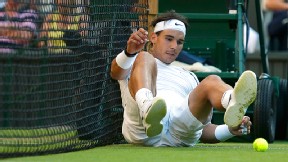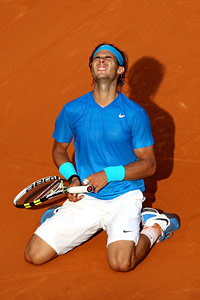The long wait for Rafael Nadal's
return is, as of today, over. He is tentatively scheduled to begin his
comeback from his latest round of knee troubles at an exhibition in Abu
Dhabi, United Arab Emirates, starting Dec. 27. If all goes as planned,
he'll make his Grand Slam return at the Australian Open the following
month.
 AP Photo/Anja Niedringhaus
One
thing does seem certain this time: Nadal will alter his playing
schedule at some point to include more clay and less time on his dreaded
hard courts. If he decides to play the sleepy South American clay
circuit, he might single-handedly make it a vital stretch of the tour.
AP Photo/Anja Niedringhaus
One
thing does seem certain this time: Nadal will alter his playing
schedule at some point to include more clay and less time on his dreaded
hard courts. If he decides to play the sleepy South American clay
circuit, he might single-handedly make it a vital stretch of the tour.
In the past, age 26 has been considered a tipping point toward decline in a great tennis player's career; neither Bjorn Borg nor John McEnroe won a Grand Slam after age 25. But to paraphrase Bob Dylan, tennis players were so much older then, they're younger than that now. With Federer, Fish, Isner, Serena, Stosur and Li Na, we know that a player's late 20s can be prime years now.
To get an idea of how good Nadal will be when he returns, it may be more helpful to look at his own history. As we know, this isn't his first comeback.
In 2006, Nadal missed the Australian Open with a foot injury. When he returned a month later, his results were initially mixed. He handed Roger Federer one of his five defeats that year but was upset by James Blake and Carlos Moya at Indian Wells and Key Biscayne.
Clay, as it so often has been for Rafa, was the answer to his troubles. He went 24-0 on it that spring and capped his run with a win over Federer in the French Open final. Asked years later which of his French Opens meant the most to him, he would say 2006, because he remembered how down he had been when he had pulled out of the Aussie Open a few months earlier.
In 2009, Nadal missed Wimbledon because of tendinitis in both knees. He came back that summer, staggered through the U.S. Open with another injury, an abdominal tear, before being thrashed by Juan Martin del Potro in the semifinals. At the World Tour Final that November, where he lost all six sets he played, Nadal was a shadow of his usual self. He began to find his form in the Davis Cup final a couple of weeks later, but it took until Monte Carlo the following spring before we saw Nadal at his best again. From there, he won three straight Slams in 2010 and finished the year at No. 1.
What can we take from this history? First, Nadal uses his low moments as motivation; he thrives when he's on the comeback trail. This doesn't mean, as some like to say, that he doesn't like being No. 1. In 2011, when he had that ranking, it was only Novak Djokovic who beat him in important matches. What it does mean is that he knows what the process of climbing the mountain again is like and that he'll look back at his time on the sidelines for motivation. Suffering, as he likes to say, is good for him.
What's also noticeable is that it took Nadal longer in 2009-10, when he suffered other injuries along the way, to get all the way back than it was in 2006. But in both cases, it was clay, specifically Monte Carlo clay, that did the trick. That's his starting point, the event he has won eight straight times. It's what has always propelled him through the core of the season, from May clay to June grass to September DecoTurf. If Rafa is smart, he'll focus on that core in the future and minimize his hard-court play.
There will likely be struggles early for Nadal again. It's hard to imagine him winning in Melbourne. And we'll see whether he comes to the U.S. for the spring hard-court events, heads south or just stays home.
But if you're going to ask whether Rafa can get back to where he was, you have to answer another question first: Do you really see him losing in Monte Carlo?
 AP Photo/Anja Niedringhaus
AP Photo/Anja Niedringhaus
Rafael Nadal's knee problems led to his second-round loss at Wimbledon this year.Nadal
hasn't played a match since losing in the second round at Wimbledon in
June. During his absence, there has been speculation about whether this
is the beginning of the end for Rafa. You can see why -- he's 26, he's
been on tour for 10 years, and he's spent that decade playing a
punishing, labor-intensive brand of tennis. Five years ago, many people
wondered if he would even still be on tour at this age.
In the past, age 26 has been considered a tipping point toward decline in a great tennis player's career; neither Bjorn Borg nor John McEnroe won a Grand Slam after age 25. But to paraphrase Bob Dylan, tennis players were so much older then, they're younger than that now. With Federer, Fish, Isner, Serena, Stosur and Li Na, we know that a player's late 20s can be prime years now.
To get an idea of how good Nadal will be when he returns, it may be more helpful to look at his own history. As we know, this isn't his first comeback.
In 2006, Nadal missed the Australian Open with a foot injury. When he returned a month later, his results were initially mixed. He handed Roger Federer one of his five defeats that year but was upset by James Blake and Carlos Moya at Indian Wells and Key Biscayne.
Clay, as it so often has been for Rafa, was the answer to his troubles. He went 24-0 on it that spring and capped his run with a win over Federer in the French Open final. Asked years later which of his French Opens meant the most to him, he would say 2006, because he remembered how down he had been when he had pulled out of the Aussie Open a few months earlier.
In 2009, Nadal missed Wimbledon because of tendinitis in both knees. He came back that summer, staggered through the U.S. Open with another injury, an abdominal tear, before being thrashed by Juan Martin del Potro in the semifinals. At the World Tour Final that November, where he lost all six sets he played, Nadal was a shadow of his usual self. He began to find his form in the Davis Cup final a couple of weeks later, but it took until Monte Carlo the following spring before we saw Nadal at his best again. From there, he won three straight Slams in 2010 and finished the year at No. 1.
What can we take from this history? First, Nadal uses his low moments as motivation; he thrives when he's on the comeback trail. This doesn't mean, as some like to say, that he doesn't like being No. 1. In 2011, when he had that ranking, it was only Novak Djokovic who beat him in important matches. What it does mean is that he knows what the process of climbing the mountain again is like and that he'll look back at his time on the sidelines for motivation. Suffering, as he likes to say, is good for him.
What's also noticeable is that it took Nadal longer in 2009-10, when he suffered other injuries along the way, to get all the way back than it was in 2006. But in both cases, it was clay, specifically Monte Carlo clay, that did the trick. That's his starting point, the event he has won eight straight times. It's what has always propelled him through the core of the season, from May clay to June grass to September DecoTurf. If Rafa is smart, he'll focus on that core in the future and minimize his hard-court play.
There will likely be struggles early for Nadal again. It's hard to imagine him winning in Melbourne. And we'll see whether he comes to the U.S. for the spring hard-court events, heads south or just stays home.
But if you're going to ask whether Rafa can get back to where he was, you have to answer another question first: Do you really see him losing in Monte Carlo?
Source: http://espn.go.com/tennis/blog/_/name/tennis/id/8456046/tennis-rafa-rafa-again

Aucun commentaire:
Enregistrer un commentaire